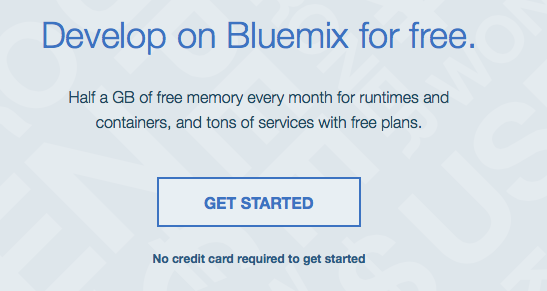Free IBM Bluemix Developer Resources

First, I put a beautiful picture with a robot to attract attention, because we all love robots. But then I replaced it with this boring screenshot from the IBM Bluemix website , because we all love money. More precisely do not like to spend them. The screenshot is quite informative, but below I'll write out the details a bit. So what does a developer get for free?
Those who know about Bluemix have heard about the 30-day free trial. But for some reason, not everyone went further and studied the tariffs in order to understand that after the trial, for a regular developer or a small blog owner, little changes.
What is there in Bluemix?
- PaaS, built on the basis of CloudFoundry. The user writes code and sends it to the cloud, which does the rest, including scaling
- Containers - Docker Containers
- VMs — Openstack Managed Virtual Machines
- Services - databases, analytics, mobile development, DevOps, Watson and so on.
')
Virtual machines are still in beta, access to them must be obtained separately and the pricing policy is not yet clear. To understand the rest we will learn a couple of terms.
Gigabyte hour (GB-hour) - the amount of memory consumed by the application per hour, this is the main unit of computing resources in Bluemix. For example:
, 1GB 24 , 24 -, 2- , 12 1GB, 12 - 512MB, 36 - [2*(12*1 + 12*0.5)].
CloudFoundry supports various development languages, a specific runtime environment (for example, Python, Node.js) is called runtime.
In PaaS, a user can have up to three runtimes for free (Liberty for Java, Node.js and one to choose from), each of which consumes no more than 375 gigabyte hours per month, i.e. free threshold is 512MB per hour. For example, you can run a Java application at the same time - 1 instances x 512MB, a PHP application - 2 instances x 256MB and a Node.js application - 8 instances of 64MB. And it is provided that everything is done around the clock.
You can also run two docker containers, each giving 365 gigabyte hours for free, complete with 2 external IP and 20GB of external disk space. Those. In the simplest case, you can use two 512MB containers around the clock.
Each service has its own pricing policy, there are completely free, almost everyone has one free tariff, suitable for developing or operating a small application.
You can see the cost in detail and estimate your potential expenses in the calculator .
As you can see, there are enough resources for developing your own applications and launching existing personal needs (a blog on Ghost , for example), register, use.
Yes, I also saved the picture with the robot.
Source: https://habr.com/ru/post/264525/
All Articles
